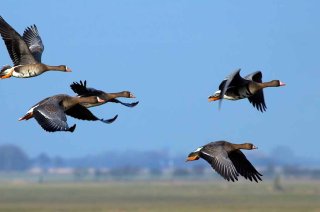
Showcase
Early warning system for detecting potential outbreaks of zoonoses
An early warning system for outbreaks of diseases that could be transmitted from animals to humans: researchers of Wageningen University & Research are building computer models that can predict where the risk of zoonoses will be the highest. Health authorities will then be able to keep an extra close eye on these hotspots.
“It is important to detect pathogens such as bacteria and viruses in animals at an early stage, so that the authorities can take timely measures to prevent these from spreading and limit the impact of the diseases they cause,” says epidemiologist Jose Gonzales. “We are building computer models that can predict where zoonoses are most likely to break out. You can think of it as an early warning system.”
The researchers are using bird flu as a test case. This virus is carried by wild migratory birds from Southeast Asia, among others, and often spreads to chickens or turkeys. The highly pathogenic variants cause severe disease and mortality in poultry. These viruses can also infect wild animals, such as foxes and wild boar, or domestic pigs. Pigs are like mixing tanks in which a virus can mutate. This sometimes produces variants that are dangerous for humans.
Pigs are like mixing tanks in which a virus can mutate. This sometimes produces variants that are dangerous for humans.
Detective work
The researchers are collecting information about the virus and adding it to the computer model. “We already know a lot about the transmission route of bird flu,” explains Gonzales. “We also monitor reports of bird flu outbreaks around the world: where did these outbreaks occur? How many animals died? Did people get sick too?”
The researchers supplement this information with their own detective work. Among others, they identify which areas in the Netherlands are most attractive to wild birds, for example because a certain food source is available there. There is a higher risk of bird flu in such areas from October to March, when many wild birds migrate to Europe. The researchers also establish which and how many wild animals live in a given area during the year and which types of farm animals they may come into contact with.
Developing algorithms
“We are developing algorithms that we can use to search the internet for news about bird flu outbreaks around the world, because even the World Organisation of Animal Health does not have a complete overview of this information,” says Gonzales. “For example, we can estimate how many animals died from the disease and how many people became infected based on local news reports. This can provide an early warning that a highly contagious variant is on its way to the Netherlands.”
Even the World Organisation of Animal Health does not have a complete overview of this information.
According to Gonzales, the computer models can also identify specific locations in the Netherlands with an increased risk of a bird flu outbreak. “These areas need to be monitored, for example by taking throat and nose swabs from different animals in such an area. Or we could use smart testing methods, such as that developed in Ralph Buij’s project. If this method is effective for bird flu, we can use it to develop computer models for other zoonoses too. Health authorities will then be able to keep an extra close eye on these hotspots, and so our models may help to prevent major disease outbreaks in the future.”